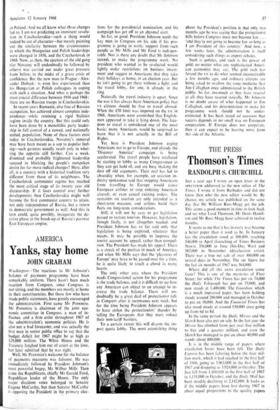Thomson's Times
THE PRESS
RANDOLPH S. CHURCHILL Just a year ago I wrote an open letter in the SPECTATOR addressed to the new editor of The Times. I wrote it from Barbados and did not know then who the new editor would be. By chance, my article was published on the same day that Mr William Rees-Mogg got the job. This seems a good moment in time to look back and see what Lord Thomson, Mr Denis Hamil- ton and Mr Rees-Mogg have achieved in twelve months.
It seems to me that it has in every way become a better paper than it used to be. In January last the circulation stood at 308,000. reaching 346,000 in April (launching of Times Business News), 356,000 in June (Six-Day War) and 385,000 in November (devaluation crisis). There was a true net sale of over 400,000 on several days in November. The ABC figure for the last six months of 1967 was 364,000.
Where did all this extra circulation come from? This is one of the mysteries of Fleet Street; for while The Times has put on 74,000 the Daily Telegraph has put on 55,000, and now stands at 1,400,000. The Guardian, which is a much improved paper, has been holding steady around 280,000 and managed in October to put on 10,000. And the Financial Times has also stood steady at around 150,000 since going up from 6d to 8d.
In the same period the Daily Mirror and the Sketch have also put on sale. In the last year the Mirror has climbed from just over five million to five and a quarter million, and even the Sketch has managed to put on about 40,000 and stands about 880,000.
It is in the middle range of papers where circulation losses have been felt. The Daily Express has been faltering below the four mil- lion mark, which it had reached in the first half of 1966, going to 3,963,000 in the first half of 1967 and dropping to 3,924,000 in October. The Sun fell from 1,160,000 in the first half of 1967 to 1,131,000 in October, and the Daily Mail has been steadily declining to 2,142,000. It looks as if the middle papers have lost during 1967 in about equal proportions to the quality papers and popular illustrateds—with The Times and the Daily Mirror getting the lion's share. The Times's increase in circulation has not been great enough to warrant an increase in its advertising rates. None the less, by using more pages, advertising revenue has increased by 7 per cent during the year (this is slightly less than the increase in column inches because of discounts given on long-term advertising con- tracts).
The following table shows how advertising varied last year in the quality papers, both daily and Sunday :
Increase! decrease in column inches
Per- cent-age increase! decrease
The Times +1,544.1 + 9.2 Financial Times + 315.2 + 1.7 Daily Telegraph —1,998.1 — 6.1 Guardian —2,091.19 —14.6 Sunday Times +1,144.18 + 8.6 Sunday Telegraph — 315.8 -- $.7 Observer — 697.5 — 9.0 When at the end of 1966 Lord Thomson acquired The Times from the Astors, it was assumed that, running on the old basis, the loss for 1967 would be between £500,000 and £750,000. In fact, it was nearer £1,500,000. The four extra pages which have been added alone account for £600,000 while advertising promo- tion has cost £300,000. The editorial staff has been increased by 40 per tent. The Business News section alone requires a staff of forty. Three foreign posts have been restored and two new ones created—in Vietnam and Latin America. It is probable, particularly with the rise in cost of paper, that The Times will lose as much money this year as last year; but Lord Thomson is quite unruffled by this. He expects to reach a circulation of 500,000 by the middle of 1969.
When one remembers the elaborate inquisi- tion to which Roy Thomson and Denis Hamil- ton were subjected by the Monopolies Com- mission and all the snide attacks that were made to the effect that the editor would be interfered with and Thomson would commercialise The Times, the achievements for the last year can be judged as remarkable—more remarkable when one reflects on the continuation of the Govern- ment squeeze and the results of devaluation.
Meanwhile, what about the prices of daily newspapers? The Daily Mirror, having waited its statutory period since applying to the Board of Trade for a rise of a Id, will probably go up to 5d on 27 January. This penny rise will almost certainly be followed by the Express. the Mail, Sun and the Daily Sketch. The Financial Times, having a circulation of less than 200,000, did not have to seek permission when a couple of months ago it went up by 2d to 8d. What of the quality papers—The Times (6d), Daily Tele- graph (4d) and the Guardian (5d)? The Times, with its urgent need for more circulation, is the least likely to be tempted and will certainly not go up unless it gets a lead from the Telegraph. The Telegraph would rather not go up but it has to think about its heavy and sustained loss on the Sunday Telegraph and the diminishing profitability of coloured . supplements. The Guardian will wait and see. It could hardly afford to move alone.
These price rises will not do the papers much good if the unions start making extravagant 'claims for higher wages. Talks are now going on between the newspaper proprietors and the unions. So far it looks as if the unions will adopt a reasonable view and will agree that any wage increase shall be accompanied by the removal of some of the worst restrictive practices.































 Previous page
Previous page